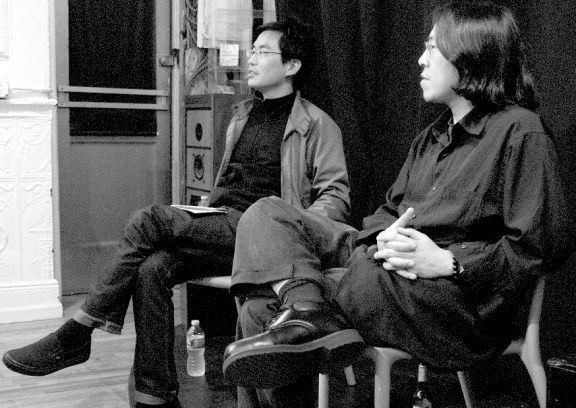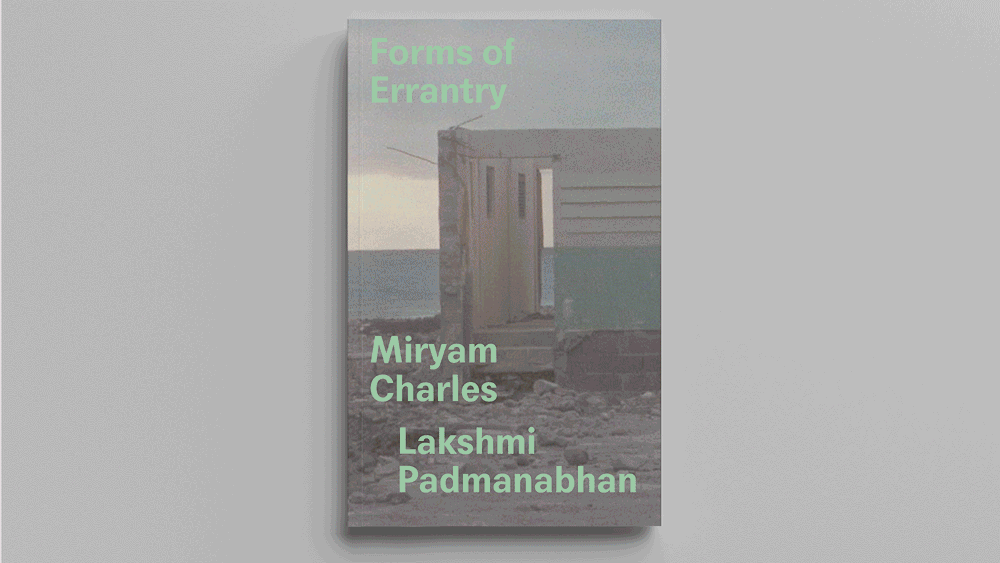James T. Hong is on to something. At the conclusion of the hour-long discussion that followed his Sunday night screening at UnionDocs, a friend turned to me and said: “I think I found a new hero”. That exhilaration, shared by myself and, it seemed, everyone I spoke with, is difficult to account for given that Hong showed only 45 minutes of his own work. On top of the two short shorts of his own, Behold The Asian (1998) and Taipei 101 (2004), he presented excerpts from films important to his development. He is as canny a programmer as he is a filmmaker, and with these clips he created a context for himself that offers some hint of what he is up to. Hong works within established forms — experimental documentary, and the video essay, mainly. Both of the shorts he screened begin in familiar territory. But each of them move quickly towards less comfortable ground and by the time they end, it is hard to be sure of what you have just witnessed. Hong’s confrontational films explode the established pieties of the political avant-garde, re-drawing the map of territory claimed long ago.

In 2003, just after SARS panic had peaked, Hong traveled to Taiwan to explore Taipei 101, then the world’s tallest building. He was sick when he returned, and though it wasn’t SARS, he chose to structure the video he shot there around the symptoms of his illness. But Taipei 101: A Travelogue of Symptoms diagnoses more than a respiratory condition. Hong is instead concerned with what he calls Taiwan’s “schizoid relationship with the United States”. He finds signs of the affliction in the skyscraper’s mall, an almost parodic celebration of American style consumerism, and in the scapegoating of East Asia occasioned by recent pandemic scares. The one scene shot inside the Taipei 101 mall captures a landscape indistinguishable from the United Sates save for the face masks worn by shoppers. Savaging American capitalist hegemony and the fealty paid it by the Taiwanese government in recent years, Hong draws an equation: America + SARS = Taipei 101. But he finds the cardinal symptom elsewhere: the streets dotted with white American men who flock to Taiwan for sex. Hong reserves his greatest scorn for these dehumanizing sexual appetites, grown in the backwash of racial exploitation. Despite the diagnostic overtones, his narration sounds nothing like the dispassionate language of medical observation. This is a full-fledged harangue, riddled with vulgarity and a loud, overdriven recording of Hong’s hacking cough. The ‘sensitive version’ he presented at UnionDocs, his preferred cut, censors the expletives as well as large portions of Hong’s analysis — a variation on the old Allen Funt trick that here wrings comedy from fury.
The gallows humor is not unlike that of Tribulation 99 (1992), Craig Baldwin’s found footage classic, from which Hong excerpted at the beginning of the evening. But Hong’s mixture of laughter and rage is thornier than Baldwin’s elegantly ironic indictment of the United States’ 20th century ventures into Latin American. Hong was raised in the U.S., but his parents come from Mainland China by way of Tawain. In Taipei 101, and its streamlined companion, A Portrait of Sino-American Friendship (2007)*, he takes a personal stake in the fraught, uneven relationships between the United States, China, and Taiwan. These films are salted with a disgust that Hong does not reserve for general questions of policy. Cheap Taipei 101 oozes spleen, and not without reason. In Taiwan, he finds manifestations of white supremacy, internalized and imposed, at every turn — from “Whitemen” brand toothpaste to the economic instability of national art cinema. Coughing and swearing into the microphone, and rubbing our noses in things we would rather not see, Hong spares the audience none of his contempt. During a montage of white man-Asian woman couples he has recorded in the streets, he singles out a particularly schlubby male specimen and invites his viewer to “imagine this man on top of you”. Hong coats already ugly scenes with bile, ratcheting up the discomfort until you have to laugh, a provocation made doubly potent by the knowledge that Hong is dead serious.
“I have seen a lot of movies about identity politics, and I think they’re stupid”, Hong said following the show. While many of his films contend with the particularities of Asian American experience, he picks up few of the protocols developed since the emergence of Asian American and other minority cinemas in the 1970s. In too much of this work, Hong sees weakness that he finds whiny and ineffectual, and that, in the Asian American films, recalls the stereotypes of model minority complacency. Instead, he wants to make movies that “come from a position of strength”. Hong is not the first person to lodge this criticism, but his counter tactics are unusual; his films are free of both the tortured rhetorical maneuvering typical of more academic approaches and the bland affirmations of liberal variations. Other artists want to contest or problematize issues. Hong wants to brawl.
Hong’s other film in the program, Order Behold the Asian: How One Becomes What One Is, is an Asian American riff on Nietszche’s Ecce Homo, from which it borrows its title and the inspiration for its boastful chapter headings. Pictured in stark black and white 16mm, a man (played by Hong) wanders through Death Valley clothed in a conical hat and black clothing. The narration, cast in the introduction as the final recordings made by a friend who recently killed himself, charts an acquisition of political self-consciousness that moves from the overcoming of internalized racism to amor fati and culminates in a violent promise of Asian world domination. As the narration swells, Hong’s rhythmic editing becomes increasingly hypnotic. When the voiceover concludes, the figure in the desert reaches his destination. He sits down and shoots himself in the mouth, the camera held close on his face as blood pours down.
Elsewhere in the program, Hong offered clues to the meaning of this film’s bewildering progression. Among the films by other artists Hong screened were clips from Hans-Jurgen Syberberg’s Hitler: A Film From Germany (1977) and Wu Ziniu’s Nanjing 1937, a 1996 Chinese feature about the Nanking massacre, from which Hong excerpted a five-minute scene of mass execution. These works are formally apposite to Hong, but they also showcased his twin obsessions with Nazism and Japanese nationalism. He showed neither of his two films about Japan’s experiments with biological warfare– a short, 731: Two Versions of Hell (2007), and a new feature, Lessons of the Blood (2010)* –or any of his works that explore various facets of the post-Nazi aftermath —Die Entnazifizoerung Des MH (2006), Führerbunker: Touristen, Purchase Neo-Nazis, und Andere Cheap – 30 April 2009 (2009), and Surveillance of a Camp In Spring (2010). In these films, Hong charts the echoes of Japanese militarism and German National Socialism that ring throughout the present, but he also summons them in his complex engagement with what must be crudely termed “identity politics”.
In Behold the Asian, the prophesy of racial supremacy, even that of a currently marginalized minority, delivered in the Nietszchean vocabulary of will, fate, and purity alludes directly to Nazi ideology. The narration is laid over the soaring, Romantic music of Wagner and Grieg, two of Hitler’s favorite composers. Hong’s productions are too modest to attain the monumentally of Nazi propaganda, but the forceful emotional clarity of his images would not be out of place there. And the film’s depiction of a lone figure struggling through a stark expanse of harsh nature calls to mind the German mountain films that so impressed themselves on the Nazi film industry.
The position of power from which the film issues is not one of autonomy, self-determination, and difference in the face of bigotry. Hong places himself at the extreme pole of curdled racial and nationalist pride that birthed the Nazis and the Japanese Statists. In the hands of a lesser artist, this would appear as cheap, reactionary irony — a slippery-slopism that conflates the very different contexts in which these two types of pride grew and the uses to which they have been put. Hong’s politics are not always easy to parse, but his goals do not ultimately seem that different from those of the identity-oriented filmmakers whose strategies he avoids. Projecting these shadows onto the screen of minority cinema, Hong creates a kind of stereoscopy whose very instability provokes its viewers to reconsider hardened certainties.
By putting rightist aesthetics to left wing ends, Hong rebukes not only the cinema of identity, but the the bulk of the post-60s leftist film tradition. Behold The Asian Pills subverts the most persistent axiom of left political filmmaking: that truly radical content film must locate an authentically radical form. Films like Syberberg’s negotiate the toxic legacy of Nazi propaganda by adopting a distancing, analytical style denuded of the emotional appeal made by propaganda. For Hong, this is no solution. All media, and film in particular, manipulates its viewers, no matter how transparent it pretends to be. Instead of coasting on borrowed righteousness, Hong risks monstrousness in order to imbue his films with a volatility and confrontational power that was long ago sapped from more orthodox films. However true or useful the idea of legitimately leftist form may be, Hong demands its possibilities be reimagined.
In these few films and videos alone, Hong takes greater risks than most of his contemporaries in the world of experimental documentary combined. He is not unknown, but he his work has received nowhere near the attention it deserves. Hong’s willingness to do the wrong things commands an urgency missing from contemporary films and videos that are in many ways better than his. His show at UnionDocs abutted a particularly rote edition of Views From The Avant-Garde, the New York Film Festival sidebar that is supposedly the year’s premier experimental film event. In the discussion that followed the screening, programmer and writer Chi-Hui Yang noted Hong’s preoccupation with sickness. Ironically, Hong’s complex, dynamic work seems like an antidote to a malaise that has long afflicted artists patrolling the same beat. Were he accorded a greater prominence, Hong’s provocations could well start the kind of fight needed to jump start the sputtering engine of experimental leftist documentary.
*Available in diminished form here
*You can watch 731: Two Versions of Hell here for a measly €.50. Lessons of The Blood is screening Monday, October 11th at Anthology Film Archives.





